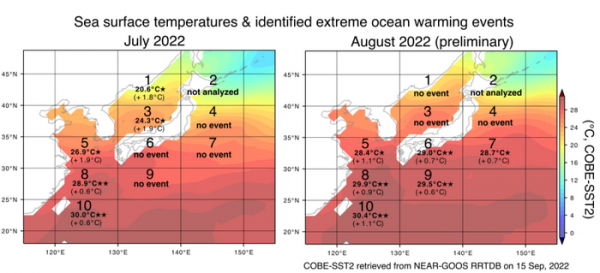In the past decade, the marginal seas of Japan frequently experienced extremely high sea surface temperatures (SSTs). A new study led by National Institute for Environmental Studies (NIES) researchers revealed that the increased occurrence frequency of extreme ocean warming events since the 2000s is attributable to global warming due to industrialization.
In August 2020, the southern area of Japan and the northwestern Pacific Ocean experienced unprecedentedly high SSTs, according to the Japan Meteorological Agency (JMA). A recent study published in January 2021 revealed that the record-high northwestern Pacific SST observed in August 2020 could not be expected to occur without human-induced climate changes. Since then, the JMA again announced that the record high SSTs were observed near Japan in July and October 2021 and from June to August 2022, but it remains unclear to what extent climate change has altered the occurrence likelihood of these regional extreme warming events.
“Impacts of global warming is not uniform, rather show regional and seasonal differences,” said a co-author Hideo Shiogama, the head of the Earth System Risk Assessment Section at Earth System Division, NIES. “A comprehensive analysis on regional SSTs for a long period may provide a quantitative understanding of how much ocean condition near Japan has been and will be affected by global warming. This better informs policymakers to plan climate change mitigation and adaptation strategies.”
Read more at: National Institute for Environmental Studies
Sea surface temperatures observed in July and August 2022 near Japan and ten monitoring areas. This figure has been updated with the latest observational data obtained after the acceptance of the paper. Area numbers where extreme ocean warming events are identified are shown with area-averaged values and anomalies relative to 1991-2020. Single- or double-star marks indicate the event frequency increases more than twice or 10 times due to global warming significantly at the 95% confidence levels. COBE-SST2 was retrieved from the NEAR-GOOS RRTDB website on 15 September 2022 and thus the results in August 2022 are yet preliminary and not included in the published article. (Photo Credit: NIES)


